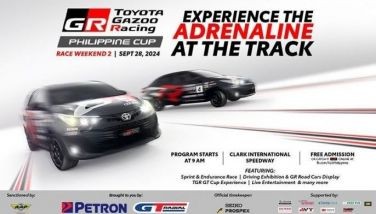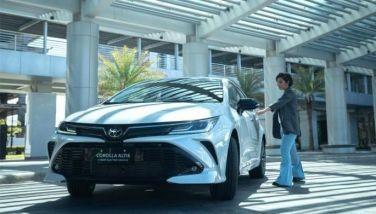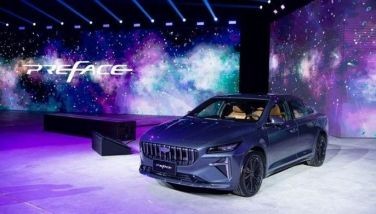Ford’s upcoming Everest: Genuine SUV or a mountain out of a molehill?
July 9, 2003 | 12:00am
Many mall-goers probably saw Ford’s upcoming new Everest when Ford Group Philippines celebrated Ford Motor Company’s centennial last month at the Glorietta Activity Center in Makati City. Judging from the sheer number of warm bodies trying to get a close look at the upcoming utility vehicle, Ford has got a winner in its hands.
I witnessed a similar reaction from the public when I first laid eyes on this vehicle way back last March at the Bangkok Motor Show where Ford gave the Everest its world premiere. The Thais, too, seemed mighty impressed with the Everest, particularly because the Ford bigwigs responsible for the creation of this vehicle appeared and spoke at length during its unveiling. Of course, an elevated platform, lots of spotlights and sexy models always add drama even to the most mundane of vehicles.
Sharp readers, by now, may have noticed a word used to describe the Everest by its absence. I have elected not to use the word "sport" in calling the Everest as Ford does repeatedly in its press literature, specifically, a "sport-utility vehicle." At least, not yet.
Let me explain. Sport-utility vehicles have long been unofficially defined as wagon-type vehicles with a four-wheel-drivetrain. However, the disappearance of 4x4 drivetrains from mainstream SUVs like the Mitsubishi Pajero, the Nissan Patrol and even the big American SUVs like the Ford Expedition and the Chevrolet Suburban/Tahoe for tax purposes has blurred the line somewhat between a bonafide SUV and a glorified Asian utility vehicle (AUV).
Variable seating configurations, leather seats, CD and even VCD players/LCD monitors, state-of-the-art multi-valve EFI gasoline engines, direct-injection diesel engines, big wheels and all-terrain tires, spare tires hung on the tailgate, plastic lower body cladding with 2-tone treatment – all these and more are found in the higher-end variants of the ubiquitous Toyota Revo, Mitsubishi Adventure and Isuzu Crosswind, AUVs all, despite what their manufacturers would have you believe.
Which is why I found myself shaking my head when I took a close look at the Everest "sport utility vehicle" inside the Bangkok International Trade Exhibition Center that March and found pretty much the same overall workmanship you’d find in a gussied up Revo, Adventure or Crosswind.
The paint finish, the panel gaps, the brackets that anchor the seats to the floor, the sound of the door when you slam it shut – they were all of AUV standards. Not substandard, mind you, but definitely some ways behind that of, say, Ford’s own Escape SUV – a genuine sport utility vehicle in every sense of those three words.
The Everest gets its chassis from Ford’s own Ranger pickup, albeit in shortened form, which is also how Isuzu and Mitsubishi derive their AUVs from their respective pickups. This is a major reason why the riding comfort of an AUV will always be closer to that of a pickup than a genuine SUV.
So, is the Everest nothing more than an inspired name from an even more inspired product planning guy for a vehicle that would be better off climbing molehills instead of its awe-inspiring namesake?
I was on the verge of saying "yes" to that question when I saw it: a small lever that sprouted from the transmission hump right beside the gearshift knob. On it said the cryptic letters 4x4H and 4x4L. Hmm. Didn’t realize this Everest is available with four-wheel-drive.
I looked around and found more evidence of high-end SUV-ness: multiple aircon vents on the ceiling, dual airbags, available automatic transmissions, an easy-to-use "flip-and-fold" second-row seat, flat-folding front-facing third-row seats for a seven-passenger capacity (instead of the ridiculously uncomfortable jeepney-type 10-seat configuration of the other AUVs), auxiliary power points for the front and cargo areas, an overhead storage console, and upon closer inspection, lots of sound insulation for that hushed cabin effect.
I searched the truck for even more telling SUV bragging rights. I found them alright: decent approach and departure angles for at least medium-duty off-roading, the aforementioned high and low-range 4WD, a limited slip differential, huge 265/70R-15 all-terrain tires, fuel tank guards, 4-wheel ABS with 2-piston front brake calipers, and last but not least, high-torque 2.6-liter gasoline and intercooled 2.5-liter 12-valve turbodiesel 4-cylinder engines.
Ford has endeavored to boldly take the AUV where no AUV has gone before: genuine off-roading. Truth be told, the 4x4 Everest will go farther than any 4x2 Expedition, come hell or high water. It will redefine the AUV-cum-SUV crossover better than its more established local rivals have when it comes to these shores. The Everest is a genuine sport utility vehicle, make no mistake about it.
I witnessed a similar reaction from the public when I first laid eyes on this vehicle way back last March at the Bangkok Motor Show where Ford gave the Everest its world premiere. The Thais, too, seemed mighty impressed with the Everest, particularly because the Ford bigwigs responsible for the creation of this vehicle appeared and spoke at length during its unveiling. Of course, an elevated platform, lots of spotlights and sexy models always add drama even to the most mundane of vehicles.
Sharp readers, by now, may have noticed a word used to describe the Everest by its absence. I have elected not to use the word "sport" in calling the Everest as Ford does repeatedly in its press literature, specifically, a "sport-utility vehicle." At least, not yet.
Let me explain. Sport-utility vehicles have long been unofficially defined as wagon-type vehicles with a four-wheel-drivetrain. However, the disappearance of 4x4 drivetrains from mainstream SUVs like the Mitsubishi Pajero, the Nissan Patrol and even the big American SUVs like the Ford Expedition and the Chevrolet Suburban/Tahoe for tax purposes has blurred the line somewhat between a bonafide SUV and a glorified Asian utility vehicle (AUV).
Variable seating configurations, leather seats, CD and even VCD players/LCD monitors, state-of-the-art multi-valve EFI gasoline engines, direct-injection diesel engines, big wheels and all-terrain tires, spare tires hung on the tailgate, plastic lower body cladding with 2-tone treatment – all these and more are found in the higher-end variants of the ubiquitous Toyota Revo, Mitsubishi Adventure and Isuzu Crosswind, AUVs all, despite what their manufacturers would have you believe.
Which is why I found myself shaking my head when I took a close look at the Everest "sport utility vehicle" inside the Bangkok International Trade Exhibition Center that March and found pretty much the same overall workmanship you’d find in a gussied up Revo, Adventure or Crosswind.
The paint finish, the panel gaps, the brackets that anchor the seats to the floor, the sound of the door when you slam it shut – they were all of AUV standards. Not substandard, mind you, but definitely some ways behind that of, say, Ford’s own Escape SUV – a genuine sport utility vehicle in every sense of those three words.
The Everest gets its chassis from Ford’s own Ranger pickup, albeit in shortened form, which is also how Isuzu and Mitsubishi derive their AUVs from their respective pickups. This is a major reason why the riding comfort of an AUV will always be closer to that of a pickup than a genuine SUV.
So, is the Everest nothing more than an inspired name from an even more inspired product planning guy for a vehicle that would be better off climbing molehills instead of its awe-inspiring namesake?
I was on the verge of saying "yes" to that question when I saw it: a small lever that sprouted from the transmission hump right beside the gearshift knob. On it said the cryptic letters 4x4H and 4x4L. Hmm. Didn’t realize this Everest is available with four-wheel-drive.
I looked around and found more evidence of high-end SUV-ness: multiple aircon vents on the ceiling, dual airbags, available automatic transmissions, an easy-to-use "flip-and-fold" second-row seat, flat-folding front-facing third-row seats for a seven-passenger capacity (instead of the ridiculously uncomfortable jeepney-type 10-seat configuration of the other AUVs), auxiliary power points for the front and cargo areas, an overhead storage console, and upon closer inspection, lots of sound insulation for that hushed cabin effect.
I searched the truck for even more telling SUV bragging rights. I found them alright: decent approach and departure angles for at least medium-duty off-roading, the aforementioned high and low-range 4WD, a limited slip differential, huge 265/70R-15 all-terrain tires, fuel tank guards, 4-wheel ABS with 2-piston front brake calipers, and last but not least, high-torque 2.6-liter gasoline and intercooled 2.5-liter 12-valve turbodiesel 4-cylinder engines.
Ford has endeavored to boldly take the AUV where no AUV has gone before: genuine off-roading. Truth be told, the 4x4 Everest will go farther than any 4x2 Expedition, come hell or high water. It will redefine the AUV-cum-SUV crossover better than its more established local rivals have when it comes to these shores. The Everest is a genuine sport utility vehicle, make no mistake about it.
BrandSpace Articles
<
>
- Latest
Latest
Latest
September 30, 2024 - 4:26pm
By EC Toledo | September 30, 2024 - 4:26pm
September 26, 2024 - 3:30pm
September 26, 2024 - 3:30pm
August 16, 2024 - 11:00am
By Euden Valdez | August 16, 2024 - 11:00am
Recommended





























